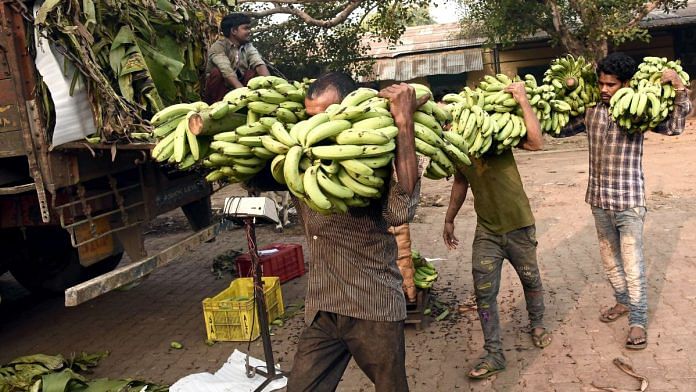Horticulture is a success story of Indian agriculture. The production of horticulture crops has increased from 169.8 million tonnes in 2004-05 to 342.32 mt in 2021-22. This transformation was initiated in 2005-06 when the National Horticulture Mission was launched by the Union government. The Centre’s share in the scheme was 85 per cent and the states were required to provide only 15 per cent. The Centre also provided 100 per cent of funds under Horticulture Mission for North East & Himalayan States.
The objective of NHM was to provide an integrated development by ensuring that forward and backward linkages were provided. Clusters were identified in 384 districts. The emphasis was on the supply of high-quality planting material. For this nurseries and tissue culture units were supported. Within five years, from 2005-06 to 2010-11, an additional area of 18.92 lakh hectares was brought under horticulture crops and 2,239 nurseries were established for the production of planting materials.
In 2014-15, NHM and HMNEH were subsumed in Mission for Integrated Development of Horticulture (MIDH) and the Centre’s share in funding for Northeastern and Himalayan states was fixed at 90 per cent. For other states, it was reduced from 90 per cent to 60 per cent.
Also Read: India’s economic indicators telling a story—of growth, recovery, robustness
All year round
Banana is one of the success stories of NHM. Due to the efforts of successive governments, bananas are affordable, and they are available around the year across India. Its price has stayed around Rs 50 to 60 per dozen for several years.
In 2004-05, 5.3 lakh ha area was under banana cultivation. By 2021-22 the area had increased to 9.6 lakh ha. In this period, the production of bananas increased from 16.2 mt to 35 mt. The productivity increased from 30.6 mt per ha to 36.5 mt per ha.
In 2021-22, India’s export of bananas reached 0.38 mt at a value of $159.09 million. But India’s share is minuscule. In 2019, global trade in bananas was valued at $13.5 billion by the Food and Agricultural Organization of the United Nations.
In 2020, then director of ICAR-National Research Centre for Banana said India is targeting 10-15 per cent of international trade with $2-3 billion of exports over the next seven to 10 years.
More than 90 per cent of banana exports are from Central and South America and the Philippines. Chiquita, Dole and Del Monte brands dominate the global markets.
India is the largest producer of bananas in the world. It produced about 35 million metric tonnes in 2021-22 which was about a quarter of global production. The highest banana-producing states are Andhra Pradesh, Maharashtra, Gujarat, and Tamil Nadu. In the last few years, farmers of nontraditional states have also taken to banana cultivation. Uttar Pradesh had a 10.45 per cent share in India’s production in 2021-22.
Also Read: Two weather events that affected India’s wheat surpluses, took it off the export market
Growth story
The success of banana production is also attributed to Jain Irrigation Systems Limited which set up a tissue culture laboratory in 1995.
Under tissue culture, a part of the plant or even a single cell or group of cells is cultured under highly controlled and hygienic conditions. Jain Irrigation propagates genetically pure, high-yielding and disease-free planting material.
Before that, they were prone to several diseases such as Panama wilt, bacterial soft rot and viral diseases. This resulted in decreased yield and lower quality.
Tissue culture plants are true to the type of mother plant and are free of disease and pests. They grow uniformly and give higher yields. Tissue culture plants enable round-the-year planting as the seedlings can be procured by farmers throughout the year. Two successive ratoons are possible in a short duration which minimises the cost of cultivation. Tissue culture enables the introduction of new varieties as multiplication is possible in a short duration.
Banana is a water-intensive crop and its water requirement is about 1,500-2,000 mm per annum. Therefore, micro-irrigation is strongly recommended in banana cultivation. It is claimed that drip irrigation and mulching can save 56 per cent of water. It also results in an increase in yield by 23-32 per cent. Precision farming can give better yields to farmers.
A 2015 Indian Council of Agricultural Research-CIPHET study on food losses found that losses in bananas were 6 per cent at the farm level and 1.7 per cent in the supply chain (up to retailers). A 2022 study by Nabcons has found that the losses were 5.2 per cent at the farm level and 2.4 per cent in the market supply chain.
Better farm practices, and improved storage, ripening and transportation by reefer vans can reduce losses and enhance the quality of Indian bananas in the international market. Going forward, high-density planting techniques developed by ICAR-National Research Centre for Banana, Tiruchirappalli can improve banana yields.
For an edge in the global market, investment in the post-harvest infrastructure of sorting, grading and packaging is needed. Even if horticulture is not covered by Agricultural Produce & Livestock Market Committee regulations in most states, the investment in such infrastructure can only be made by them. Additionally, phytosanitary standards need to be enforced.
As a healthy and affordable fruit, bananas will continue to remain important for Indian diets.
The author is a former Union Agriculture Secretary. Views are personal.
(Edited by Theres Sudeep)



